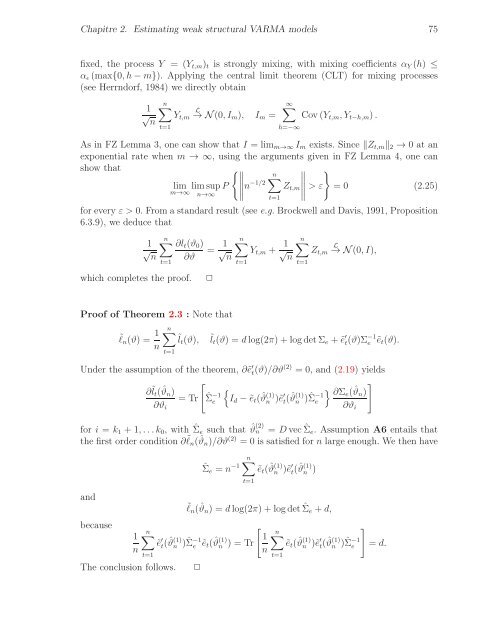THÈSE Estimation, validation et identification des modèles ARMA ...
THÈSE Estimation, validation et identification des modèles ARMA ...
THÈSE Estimation, validation et identification des modèles ARMA ...
Create successful ePaper yourself
Turn your PDF publications into a flip-book with our unique Google optimized e-Paper software.
Chapitre 2. Estimating weak structural V<strong>ARMA</strong> models 75<br />
fixed, the process Y = (Yt,m)t is strongly mixing, with mixing coefficients αY(h) ≤<br />
αǫ(max{0,h−m}). Applying the central limit theorem (CLT) for mixing processes<br />
(see Herrndorf, 1984) we directly obtain<br />
1<br />
√ n<br />
n<br />
t=1<br />
Yt,m<br />
L<br />
→ N(0,Im), Im =<br />
∞<br />
h=−∞<br />
Cov(Yt,m,Yt−h,m).<br />
As in FZ Lemma 3, one can show that I = limm→∞Im exists. Since Zt,m2 → 0 at an<br />
exponential rate when m → ∞, using the arguments given in FZ Lemma 4, one can<br />
show that<br />
lim<br />
m→∞ limsup<br />
<br />
<br />
P n −1/2<br />
<br />
n<br />
<br />
<br />
<br />
Zt,m<br />
> ε = 0 (2.25)<br />
<br />
n→∞<br />
for every ε > 0. From a standard result (see e.g. Brockwell and Davis, 1991, Proposition<br />
6.3.9), we deduce that<br />
1<br />
√ n<br />
n<br />
t=1<br />
∂lt(ϑ0)<br />
∂ϑ<br />
which compl<strong>et</strong>es the proof. ✷<br />
= 1<br />
√ n<br />
n<br />
t=1<br />
t=1<br />
Yt,m + 1<br />
√ n<br />
n<br />
t=1<br />
Zt,m<br />
L<br />
→ N(0,I),<br />
Proof of Theorem 2.3 : Note that<br />
˜ℓn(ϑ) = 1<br />
n<br />
˜lt(ϑ), ˜lt(ϑ) = dlog(2π)+logd<strong>et</strong>Σe + ˜e<br />
n<br />
′ t(ϑ)Σ −1<br />
e ˜<strong>et</strong>(ϑ).<br />
t=1<br />
Under the assumption of the theorem, ∂˜e ′ t(ϑ)/∂ϑ (2) = 0, and (2.19) yields<br />
∂˜lt( ˆ <br />
ϑn)<br />
= Tr ˆΣ<br />
∂ϑi<br />
−1<br />
<br />
e Id − ˜<strong>et</strong>( ˆ ϑ (1)<br />
n )˜e′ t (ˆ ϑ (1)<br />
n )ˆ Σ −1<br />
<br />
∂Σe(<br />
e<br />
ˆ <br />
ϑn)<br />
∂ϑi<br />
for i = k1 + 1,...k0, with ˆ Σe such that ˆ ϑ (2)<br />
n = Dvec ˆ Σe. Assumption A6 entails that<br />
the first order condition ∂ ˜ ℓn( ˆ ϑn)/∂ϑ (2) = 0 is satisfied for n large enough. We then have<br />
and<br />
because<br />
1<br />
n<br />
n<br />
t=1<br />
The conclusion follows. ✷<br />
ˆΣe = n −1<br />
n<br />
t=1<br />
˜<strong>et</strong>( ˆ ϑ (1)<br />
n )˜e′ t (ˆ ϑ (1)<br />
n )<br />
˜ℓn( ˆ ϑn) = dlog(2π)+logd<strong>et</strong> ˆ Σe +d,<br />
˜e ′ t( ˆ ϑ (1)<br />
n ) ˆ Σ −1<br />
e ˜<strong>et</strong>( ˆ ϑ (1)<br />
n ) = Tr<br />
<br />
1<br />
n<br />
n<br />
t=1<br />
˜<strong>et</strong>( ˆ ϑ (1)<br />
n )˜e ′ t( ˆ ϑ (1)<br />
n ) ˆ Σ −1<br />
e<br />
<br />
= d.
















